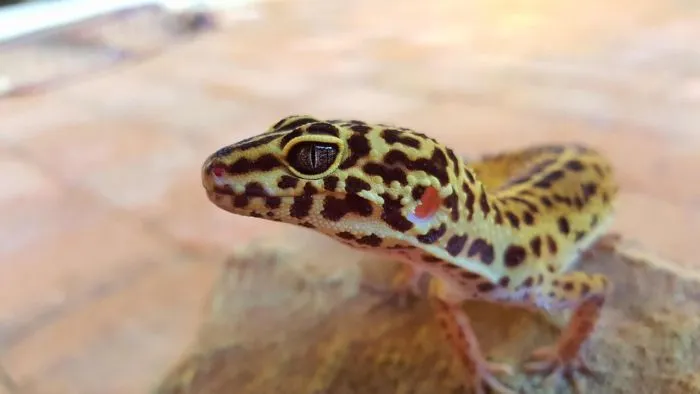 Part of getting a new pet, or thinking about buying one, is finding out if the pet you are interested in is dangerous in any way. Leopard geckos are no exception. Many people, especially those new to reptiles, often wonder if these small creatures are okay to have, especially in a family setting.
Part of getting a new pet, or thinking about buying one, is finding out if the pet you are interested in is dangerous in any way. Leopard geckos are no exception. Many people, especially those new to reptiles, often wonder if these small creatures are okay to have, especially in a family setting.
Why leopard geckos are not dangerous at all? So long as these small reptiles are taught to be handled properly, they aren’t dangerous at all. They are like any other pet – they have to be “socialized” and cared for. They are not known to be mean so long as they are treated with care.
So exactly what is it that makes these little fellows good pets? Why are they not dangerous? Keep on reading to find out more.
Their Size Makes Them Great – Their Bites Aren’t Strong
Unlike some larger reptiles, a bite from a leopard gecko will not really hurt you.
Sure, it may scare you, but it is not a big deal compared to some others. And, you may never have to deal with a bite, so long as you socialize and handle them correctly! We show you more on Leo bites in this article: Do Leopard gecko bites hurt?
Their size overall is the first indicator you are not dealing with anything that can hurt you. These little reptiles only get to a max of about ten inches long, from tip to tail.
It means you can easily keep them in a ten-gallon (we recommend 20-gallon for adults) habitat that fits nicely about anywhere in your home.
It Is Easy to Care for Them
These pets aren’t dangerous in the sense that they are difficult to care for like big monitor lizards for example. As a matter of fact, leopard geckos are suitable for beginner reptile keepers.
Leopard geckos do not need you to be a herpetologist to be a great keeper. You can easily make an excellent habitat for your gecko by shopping online at a good online retailer like Chewy or Amazon, or even by stopping into your local pet store that carries reptile supplies.
You can easily recreate the settings a leopard gecko lives in. Using special light bulbs, you can create the perfect light settings that will make your gecko happy and feel safe in his habitat.
Another bonus is that these guys are not picky about what they eat. No, you can’t just feed them anything- you have to provide special
And lastly, many of these little fellows will drink from their water bowl or even get inside it, soaking up the water that way. Another bonus is that leos do not generally require misting thanks to them being a desert species.
Kids and Families Love Them – Not Aggressive and Not Poisonous
One thing we get from parents with kids interested in reptiles is, “Are these okay around kids?”
The answer is YES. These cute little reptiles are good for kids that are ready to take on the big responsibility of owning a pet and caring for them.
They are not violent at all, nor are they poisonous. Children can handle a leopard gecko without fear.
Granted, handling is NOT an overnight process (we will talk about that next) and will require plenty of patience on your part, but it will be a fun experience when your leo is finally used to seeing hands come into his habitat.
If you Leopard gecko is aggressive it is actually defensive behavior. We show you 5 reasons for such behavior and what you can do about it here.
And their personality is just perfect for families. They have a very calm and docile way about them, and they will make all family members happy. Their eyes are large, and their face is structured by Mother Nature to look like they are smiling.
We explain how friendly Leopard geckos truly are here – After reading it you will understand their nature a little better!
Aside from having great personalities, you will never run out of morphs, or color schemes, that these geckos possess.
Do a quick image search, and you will see that there are white geckos, the color of snow, orange ones that resemble the color of the fruit, and even red ones that would blend in with the desert sands.
And parents, if you haven’t had to do this already, you will someday: you will have to explain to your child what happened to their pet after they pass away.
Most parents use euphemisms to do this, but it doesn’t lessen the pain. The good news is that with geckos, you can look forward to a long lifespan-20 year, in some cases!
Handling A Leopard Gecko
Now we are going to talk about something REALLY important, especially if you plan on bringing a leopard gecko home to a family with young children.
Youngsters are great in that many of them are curious about the world around them-they want to pet every cat and hug every dog. Geckos are not as sturdy as some pets, and kids and parents alike have to be educated about handling them with care.
Handling Part One: When to Begin
Once you have brought home your new leopard gecko, your family will probably want to begin playing with them immediately.
However, there has to be a two-week buffer period before anybody begins handling their new friend. Perhaps the most dangerous part of owning a leopard gecko is the fact that their tails can drop if they are mishandled or that their trust in you can be affected if handled incorrectly.
The reason it is important to wait two weeks is thanks to the time it takes for them to get used to their new home. After all, many of these reptiles are shipped and need time to adjust from their transportation to their new habitat.
During these two weeks, allow your gecko time to get used to his habitat. Then, after two weeks are over, slowly reach your hand into the enclosure for just a minute each night.
You might even dust your fingers with
He will also learn what your hand smells like and come to understand you are not a threat. Make sure you avoid using strongly scented soaps and lotions when working with your gecko. (We wash our hands in unscented organic soap when dealing with our geckos).
Handling Part 2: Increasing the Time
Once you find that your gecko is okay with your hand being in the
Begin with short, five-minute sessions of handling time. Do this every other day. As you do these sessions, try to go a little longer every time.
Place your hand in the
Only allow your pet to crawl into your hand. NEVER lift him by the tail. Your gecko can detach his tail, and it may or may not grow back.
Sit on the ground and keep hands low in case your gecko jumps. Handling should always be a positive and happy experience. If a gecko gets injured during this exercise, trust could be diminished.
It’s also a good idea to talk to your gecko, so he knows what your voice sounds like. Do not make any sudden movements or loud noises. You might even turn off your phone or put it on silent.
You should also avoid handling your gecko during the day. Leopard geckos are more active at night and could become annoyed during the day if handled at that time. It is usually the hours of 6 PM, and beyond that, your spotted friend will be ready to be handled.
In sum, leopard geckos are not dangerous at all, but mishandling them could lead to some consequences you do not want.
Signs of A Stressed Gecko
Leos are not dangerous, but they are like any other animal in that they get stressed out and need some time to relax if this happens.
They may bite or make noises to indicate their stress. Their bites do not hurt, but they can take a person by surprise and cause them to drop the animal.
Therefore, keep eyes open for the signs of a gecko that needs a break:
- Screaming: This is common in babies and the reason behind why we don’t handle leos until they reach at least three inches in length. It is a behavior designed to make predators startled and go away.
- Squeaks/Chirps: Your leo is not pleased with his environment. Handling is a cause for this. Calmly place him back in his habitat and give him a break. (More on why leopard geckos click and chirp here!)
- Bark: You will hear this when you have a hungry leo.
Conclusion
No, leopard geckos are not dangerous at all. However, you must be aware of the proper handling techniques so that you don’t end up in a situation with a stressed-out gecko, a gecko without a tail, or a gecko that sustains injury from being mishandled.
Keep a close eye on children and other pets when they are around your gecko to make sure they are not under any undue stress.
- Eastern Rat Snake: Nature’s Pest Control and Fascinating Reptile - September 20, 2024
- Eastern Racer: The Fast and Agile Snake - September 19, 2024
- The Eastern Indigo Snake: The Majestic, Non-Venomous Hunter of the Southeast - September 18, 2024
